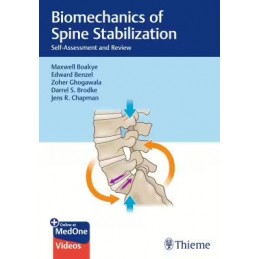- Reduced price

Order to parcel locker

easy pay


 Delivery policy
Delivery policy
Choose Paczkomat Inpost, Orlen Paczka, DHL, DPD or Poczta Polska. Click for more details
 Security policy
Security policy
Pay with a quick bank transfer, payment card or cash on delivery. Click for more details
 Return policy
Return policy
If you are a consumer, you can return the goods within 14 days. Click for more details
Reader-friendly, question and answer review of spine stabilization biomechanics honors original tome
Self-assessment and review of both old and new techniques facilitates comprehensive understanding of principles that underlie spine stabilization biomechanics. Biomechanics of Spine Stabilization:: Self-Assessment and Review edited by renowned spine surgeons Maxwell Boakye, Edward Benzel, Zoher Ghogawala, Darrel S. Brodke, and Jens R. Chapman emphasizes core topics from Biomechanics of Spine Stabilization. First published in 1995, with a third edition in 2015, this widely acclaimed textbook by Edward Benzel is considered the bible of biomechanics of spine stabilization.
Organized in nine sections and 39 chapters, this practical learning tool is designed to inform and make biomechanics routinely and practically accessible in clinical spine practice. The book starts with an overview of fundamental concepts, followed by two sections on spine and neural pathology and spine surgery. Sections 4-6 test knowledge of spine instrumentation general principles; regional considerations; and deformity, management, and prevention. Sections 7-8 cover iatrogenic pathologies, the latest spine surgery techniques and technologies, and non-operative spine stabilization. The book concludes with a final section on putting biomechanical concepts into practice.
Key Features
This indispensable resource will help spine residents, fellows, and orthopaedic and neurosurgical spine surgeons better understand clinically important biomechanical principles that underpin spinal surgery and instrumentation, thereby enhancing evidence-based decision making.
This print book includes complimentary access to a digital copy on https://medone.thieme.com.
Publishers Note:: Products purchased from Third Party sellers are not guaranteed by the publisher for quality, authenticity, or access to any online entitlements included with the product.
Data sheet
Part I: Overview of Fundamental Concepts
1. Biomechanically Relevant Anatomy and Material Properties of the Spine and Associated Elements
2. Physical Principles and Kinematics
3. Stability and Instability of the Spine
Part II: Spine and Neural Element Pathology
4. Bone Quality
5. Degenerative and Inflammatory Diseases of the Spine
6. Trauma, Tumor, and Infection
7. Spinal Deformations
8. Neural Element Injury
9. Correlation of the Anatomical and Clinical Domains
Part III: Spine Surgery
10. Surgical Approaches to the Subaxial Spine
11. Destabilizing Effects of Spine Surgery
12. Spine Fusion
Part IV: Spine Instrumentation Constructs: General Principles
13. Implant Material Properties
14. Component–Component Interfaces
15. Implant–Bone Interfaces
16. Qualitative Attributes of Spinal Implants: A Historical Perspective
17. Quantitative Attributes of Spinal Implants
18. Construct Design
19. Construct Failure and Prevention
Part V: Spine Instrumentation Constructs: Region Specific Considerations
20. Craniocervical and Upper Cervical Constructs
21. Ventral Subaxial Spine Constructs
22. Dorsal Subaxial Spine Constructs
23. Interbody Constructs
24. Lumbosacral-Pelvic Constructs
25. Regional Nuances
Part VI: Spine Instrumentation Constructs: Deformity, Management, and Prevention Strategies
26. Deformity Prevention and Correction: Component Strategies
27. Deformity Prevention and Correction: Complex Clinical Strategies
28. Complex Instrumentation Constructs and Force Applications
Part VII: Iatrogenic Pathologies and New Spine Surgery Techniques and Technologies
29. Subsidence and Dynamic Spine Stabilization
30. Vertebral Augmentation
31. Adjacent Segment Degeneration and Diseases
32. Motion Preservation Technologies
33. Minimally Invasive Spine Surgery
34. Construct Failure and Failure Prevention: The Decision-Making Process
Part VIII: Non-Operative Spine Stabilization
35. Bed Rest and Traction
36. Spine Bracing
37. Exercises, Conditioning, and Other Nonoperative Strategies
Part IX: Synthesis: Putting It All Together
38. Biomechanical Testing
39. Decision-Making Process: A Reprise
